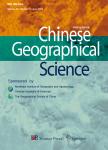Geographical Space Development Zone Classification:An Essential Guide for Transformation of Mountain Resource Cities
Geographical Space Development Zone Classification:An Essential Guide for Transformation of Mountain Resource Cities作者机构:Institute of Mountain Hazards and EnvironmentChinese Academy of Sciences
出 版 物:《Chinese Geographical Science》 (中国地理科学(英文版))
年 卷 期:2015年第25卷第3期
页 面:361-374页
核心收录:
学科分类:0303[法学-社会学] 12[管理学] 1204[管理学-公共管理] 07[理学] 070503[理学-地图学与地理信息系统] 0708[理学-地球物理学] 0705[理学-地理学] 0813[工学-建筑学] 0704[理学-天文学] 0833[工学-城乡规划学]
基 金:Under the auspices of National Basic Research Program of China(No.2015CB452706) National Natural Science Foundation of China(No.41301193) Knowledge Innovation Program of Chinese Academy of Sciences(No.KZCX2-YW-333)
主 题:资源型城市 地理空间 开发区 城市转型 图形分类 城市可持续发展 可持续发展能力 南山
摘 要:Sustainable development of mountain areas and resource cities has been a significant issue worldwide. Transformation of mountain resource cities is facing tremendous difficulties. In the context of National Major Function-oriented Zone Planning raised to a national strategic level in China, it is important to effectively implement the planning by studying geographical space development zone classification of prefecture- and county-level cities based on their major function orientation. This research is even more critical for the transformation of mountain resource cities. In this study, we evaluated geographical space development suitability, and classified geographical space development zones for Dongchuan Distric in Kunming City of Yunan Province, China, a typical mountain resource city. A quantitative grid-based evaluation was conducted using key-factor identification and restrictive-supportive comprehensive index determinati based on a geographic information system framework with different source data. The results included a classification of geographical space of Dongchuan into five types: the prohibited development zone, the inappropriate development zone, the controlled development zone, the moderate development zone and the preferential development zone. The distribution characteristics of geographical space development zones showed that the proportion of the prohibited development zone is the highest, while that of the other four development zones is comparatively lower and significantly fragmented. The geographical space development suitability is greatly controlled by the geomorphic pattern. Although Dongchuan is extremely restrained in terms of suitable geographical space for industrialization and urbanization, it still has the certain preferential and moderate development zones with an area of 207.81 km2 with large parts being concentrated and contiguous, which makes these areas the most favorable for development. Only by adapting to this reality and implementing centralized development strategy in the regions with higher suitability may Dongchuan achieve smooth transformation from expansion mode to compact mode and its sustainable development capacity may be improved. Suggestions with an angle of industrial and spatial development pattern were put forward for the transformation of the city in future.



